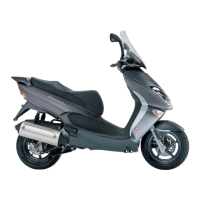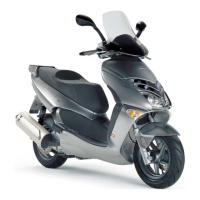9 - 15
ACTUALIZACIONES Modelo 1997 UPDATES Model 1997
6.13 SUSTITUCION FUSIBLES
No repare fusibles dañados.
No utilice nunca fusibles diferentes de los in-
dicados para no causar daños al sistema
eléctrico o incluso un incendio en caso de cortocir-
cuito.
Cuando el fusible se estropea frecuentemente
es posible que haya un cortocircuito o una so-
brecarga.
Si se da cuenta de que un componente eléctrico no fun-
ciona o funciona de manera no correcta, o de que el mo-
tor no se pone en marcha, es necesario que controle los
fusibles.
Controle antes los fusibles de 7,5 A y 15 A y luego el fu-
sible de 20 A.
Para el control:
◆ Ponga en "m" el interruptor de encendido, para evitar
un cortocircuito accidental.
◆ Levante el sillín.
◆ Quite la tapa batería, véase 2.3.1 (CONTROL NIVEL
ELECTROLITO BATERIA).
◆ Extraiga un fusible a la vez y controle si el filamento
está interrumpido.
◆ Antes de sustituir el fusible, busque, si es posible, la
causa que ha ocasionado la avería.
◆ Sustituya el fusible, si resulta dañado, con otro del
mismo amperaje.
Si se utiliza el fusible de reserva (4), (5), (6),
provea a introducir otro igual en su sede co-
rrespondiente.
COLOCACION FUSIBLES
Fusible 7,5 A (1) De conmutador de llave a:
encendido, interruptores stop.
Fusible 15 A (2) De conmutador de llave a:
todas las cargas luz.
Fusible 20 A (3) De batería a:
conmutador de llave, regulador, ventilador.
a
c
c
6.3 CHANGING THE FUSES
Do not repair faulty fuses.
Never use fuses different from the recom-
mended ones. The use of unsuitable fuses
may cause damages to the electric system or, in case
of short circuit, even a fire.
If a fuse blows frequently, there probably is a
short circuit or an overload in the electric sys-
tem.
If an electric component does not work or works irregular-
ly, or if the vehicle fails to start, it is necessary to check
the fuses.
Check the 7,5 A and the 15 A fuses first and then the 20A
fuse.
To carry aout the checking:
◆ Turn the ignition switch to position “m”, to avoid any
accidental short circuit.
◆ Raise the saddle.
◆ Remove the battery cover, see 2.3.1 (CHECKING THE
BATTERY ELECTROLYTE LEVEL).
◆ Extract the fuse one by one and check if the filament is
broken.
◆ Before replacing the fuse, try to find out the cause of
the trouble, if possible.
◆ Then replace the damaged fuse with a new one having
the same amperage.
If you use the spare fuse (4), (5), (6), put a new
fuse in the suitable seat.
ARRANGEMENT OF THE FUSES
7,5 A fuse (1) - From the key switch to:
ignition stoplight switches.
15 A fuse (2) - From the key switch to:
all light loads.
20 A fuse (3) - From the battery to:
key switch, regulator, electrofan.
a
c
c

